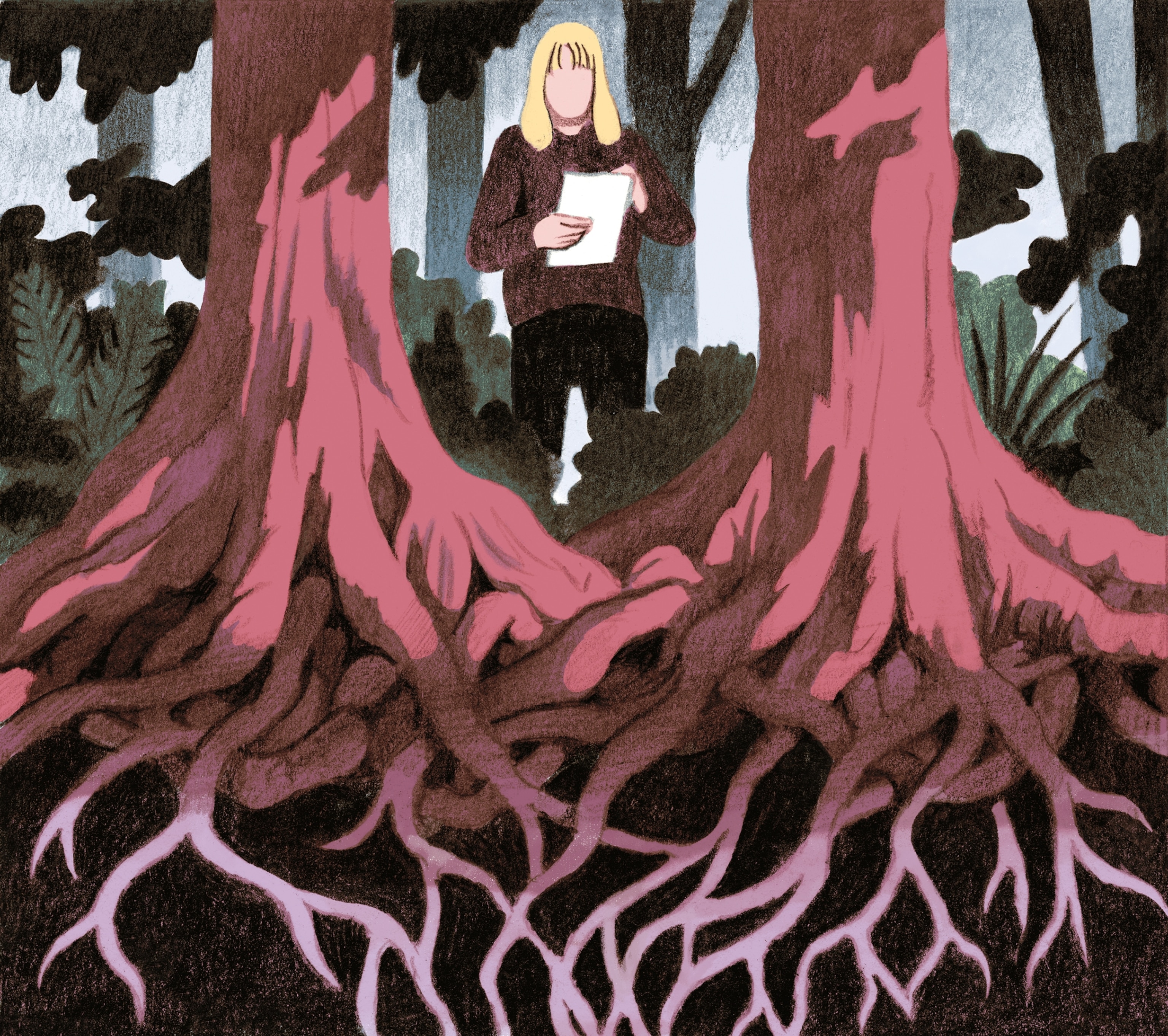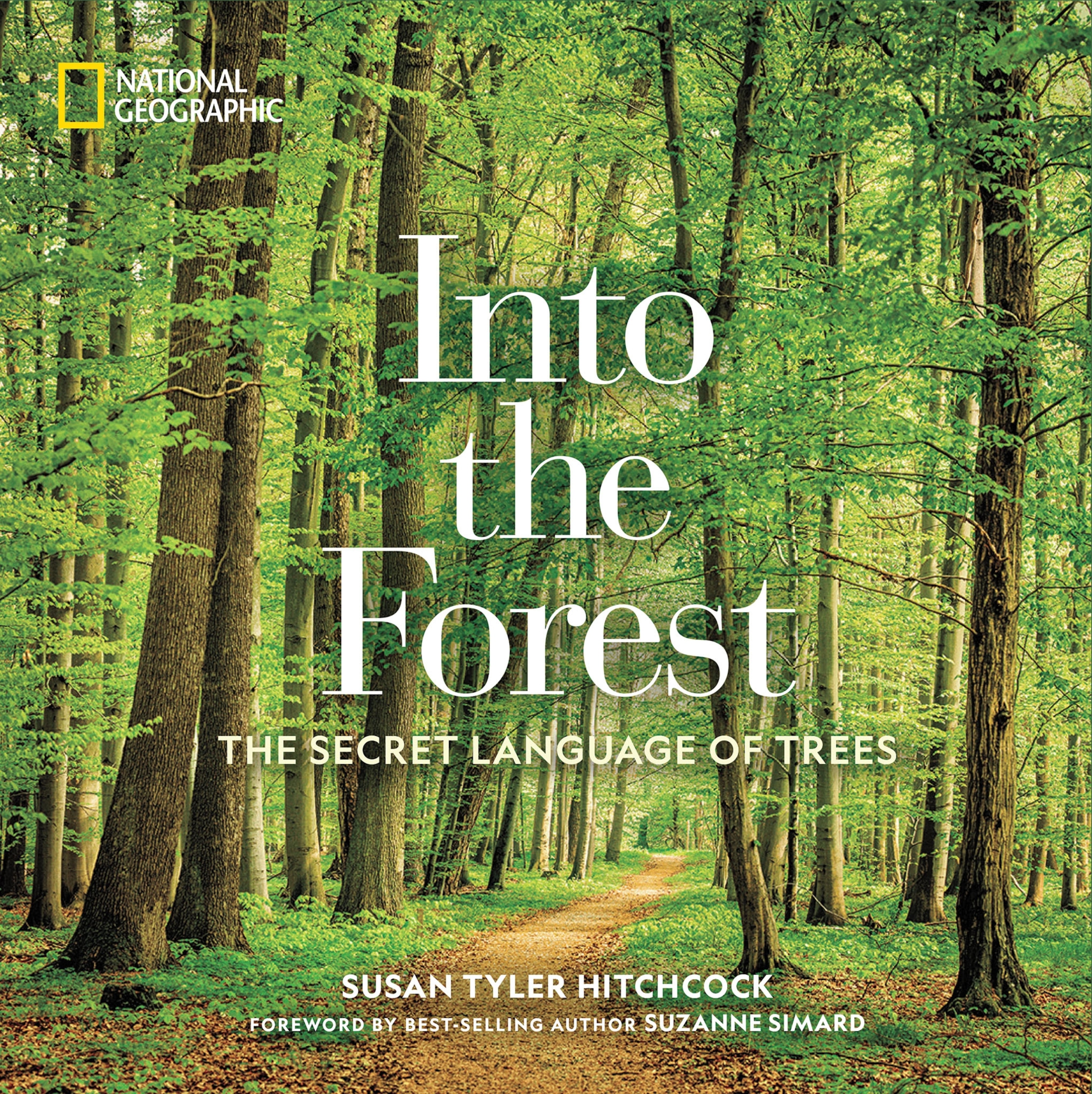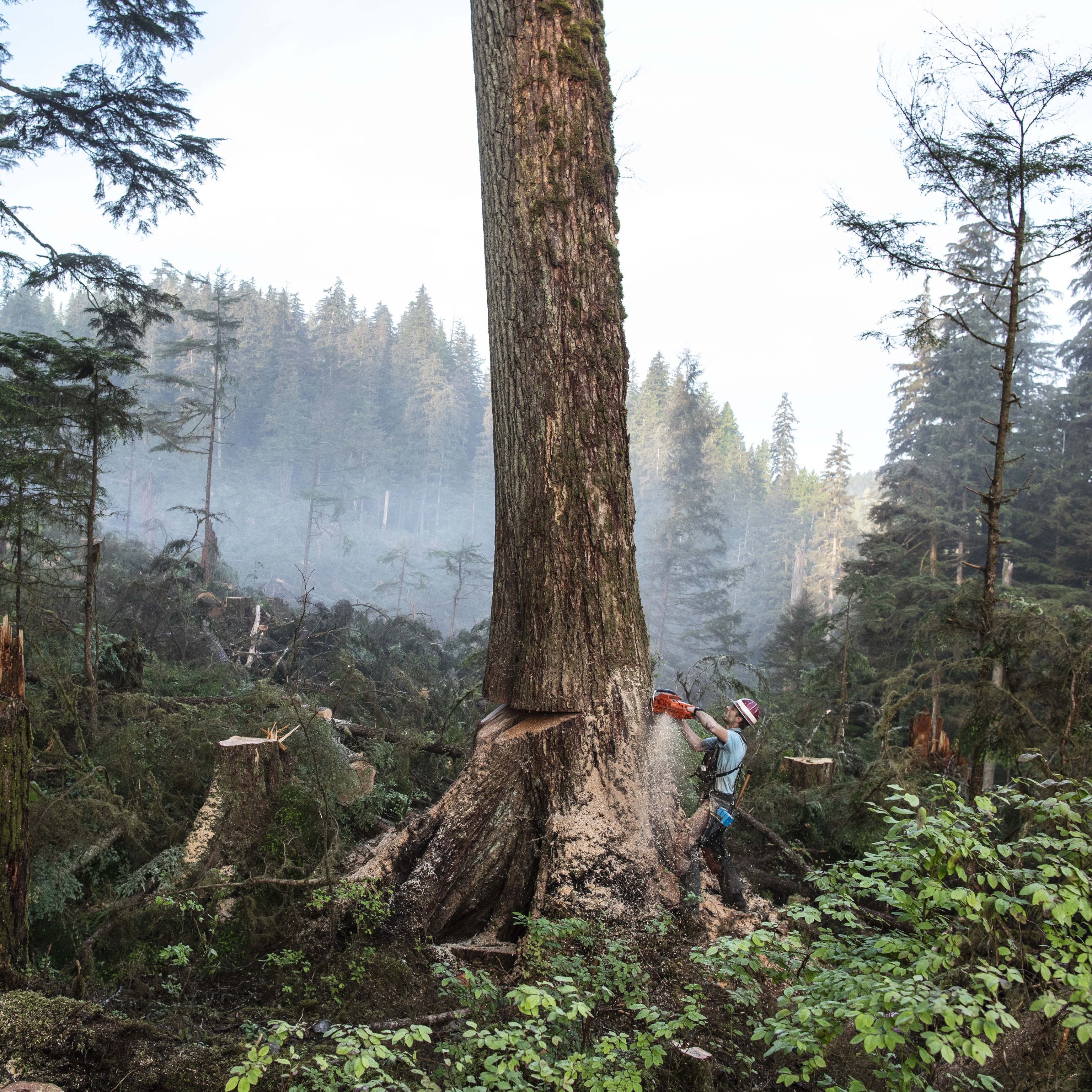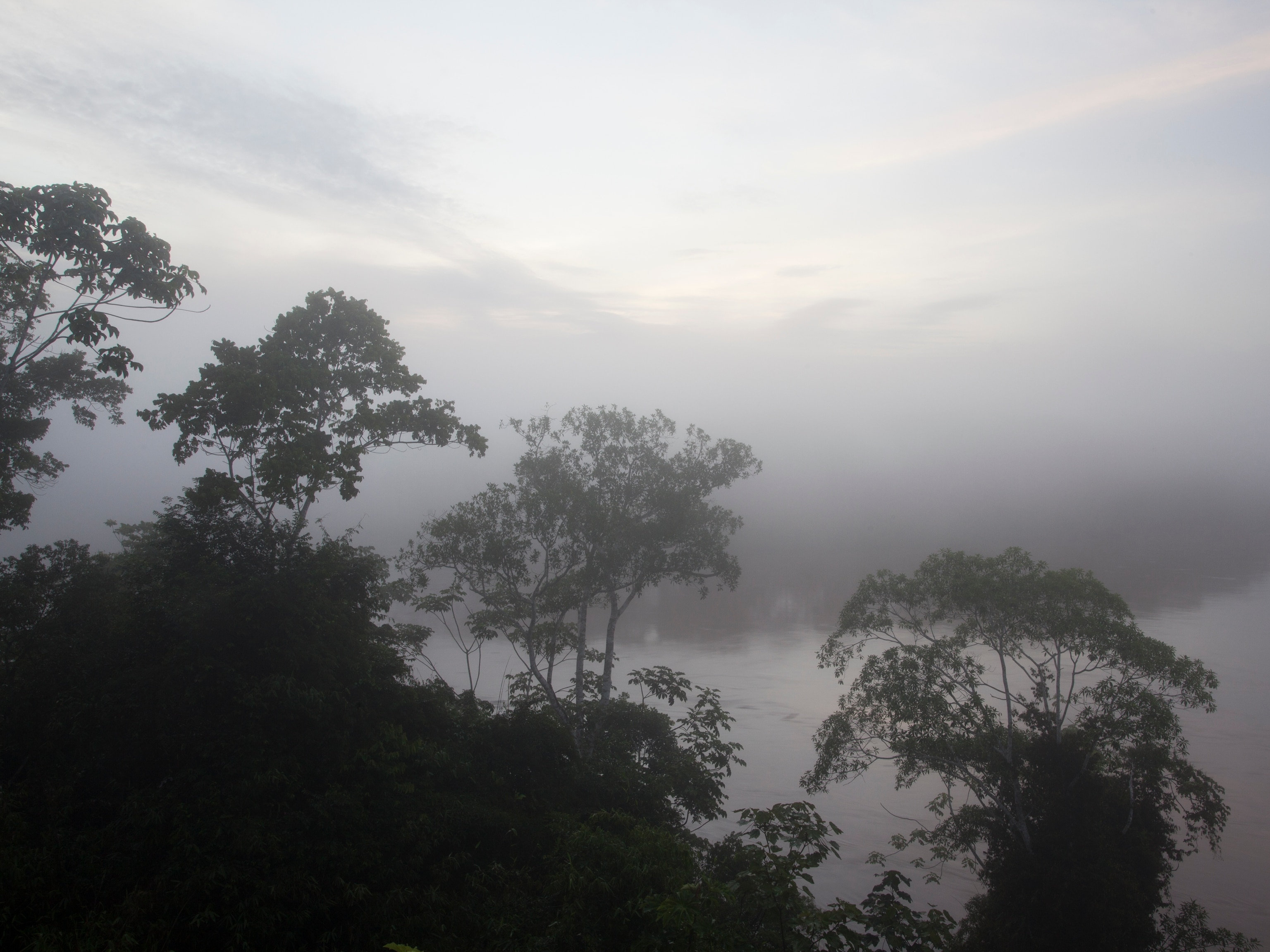Why all life on Earth depends on trees
Amid trees marked for felling, a scientist spells out forests’ vital role in saving wildlife, humanity, and a warming planet.

The hollowed-out trunk of the ancient yellow cedar felt like a cocoon with its soft floor of bark strips. A mother bear had molded this bed when she came each year to hibernate and to birth her cubs inside the 2,000-year-old tree. In the depth of winter, the shell of sapwood had protected them from the bone-chilling cold and blowing snow.
A decade earlier, the mother likely had been born in this same den, near the headwaters of Fairy Creek on Vancouver Island, off the coast of British Columbia. She would have returned each fall, fattened on berries and salmon. I picked one of her hairs from the grain of the wood, the scent of wet grass merging with the citrusy heartwood and fresh Pacific rain.
I was here with several environmental activists. Their opponents call them radicals, even eco-terrorists. They call themselves forest defenders, and they work to fend off the timber company aiming to clear-cut this forest. Half a dozen young men and women had greeted me on the newly blasted road and ushered me over huge logs and deep ravines to this wizened tree. They spoke excitedly of seeing screech owls and of marbled murrelets nesting in the canopy of the cedars, and pointed to specklebelly lichens draping the smooth bark of amabilis firs. Those birds and lichens, and many other at-risk species, live in a community of more than 325 plants, algae, mosses, and mammals, and untold numbers of fungi and microbes, in the Fairy Creek watershed.
Without these trees, the defenders knew no cubs would be born, no lichens would capture the mountain mist, and no old-growth fungi would link the matriarchs with their offspring. Huddled inside the den, the defenders worried about the impending fall rains and quietly hoped for early snow to delay the felling.
This multigenerational grove had survived millennia of climatic variation. Its experiences were encoded in trees’ seeds and rings, and the information passed from tree to tree through belowground fungal networks.
I grew up in the forests of British Columbia. My uncles and grandfather logged with horses, cutting down trees so selectively you had to hunt to see where they’d taken one. Grandpa taught me about the quiet and cohesive ways of the woods, and how my family was knit into it.
I followed in my grandfather’s footsteps. I studied forestry and took jobs in the Canadian Forest Service and lumber industry. Soon I was working alongside the powerful people in charge of the commercial harvest. But I found the extent of the clear-cutting alarming, and I felt conflicted by my part in it. On top of that, the spraying and hacking of the aspens and birches to make way for the more commercially valuable planted pines and firs were astounding. It seemed that nothing could stop this relentless industrial machine.
(The world's tallest known tropical tree has been found—and climbed)
So I went back to school, and I studied forest science. Researchers had just discovered that one pine seedling root could transmit carbon to another pine seedling root—but this was in the laboratory. I wondered, Could this happen in real forests?
I thought, yes, that trees in real forests might also share information belowground. This was controversial, and some people thought I was crazy, and I had a really hard time getting research funding. But I persevered.
The ‘wood-wide web,’ explained

In a series of breakthrough experiments conducted while dodging grizzly bears in western Canada’s rainforests, Simard discovered that trees are connected through vast fungal root systems known as mycorrhizal networks. Via this subterranean pipeline, they share carbon, water, and nutrients. The fungi extract sugars from the tree roots that they can’t produce on their own, and in return the fungi ferry water and nutrients to the tree roots and even farther, from tree to tree.
The journal Nature published Simard’s revolutionary findings in 1997, with the cover line “The wood-wide web.” Though her work provoked harsh criticism, Simard persisted, demonstrating how trees communicate and even cooperate between species, relaying distress signals about drought and disease, and trading minerals through a complex circuitry that she compared to neural networks in the human brain.
Simard has also identified “mother trees” that act as hubs for these networks. They can recognize their own offspring and shuttle extra resources to them. When these elders die, they “dump” carbon and defense compounds into the network, uploading food and information for future generations. —Kerry Banks
“Do you hear thumping?” I asked nervously.
“Helicopters!” whispered a woman next to me inside the den. We emerged to see the metal dragonfly churn over the ridge, men staring from tinted windows. Under the swirl of blades, the cedar matriarch stood at about 115 feet; her family encircled, as if telling the story of their origin and protecting her.
This multigenerational grove had survived millennia of climatic variation, insect infestations, and windstorms, and had been fed by centuries of salmon runs. The experiences were encoded in their seeds and tree rings, and the information passed from tree to tree through belowground fungal networks.
Defenses that evolved over millions of years helped these trees withstand temperature extremes and fend off herbivores. They also enabled this forest to accumulate as much carbon—580 tons per acre—as a tropical rainforest. But these defenses, we knew, were no match for the chain saws.
We ran and slipped across the steep slope to the small clear-cut carved out of the mountain, where the helicopter now hovered over a makeshift helipad. One of the defenders climbed up the platform and waved his arms as if to repel the aircraft.
The differences in worldviews between the loggers and the defenders suddenly were clapping like thunder. Everyone needed these trees, yet for different reasons. People pitched against people over an industry that no longer serves most well. Then abruptly the machine turned and flew down the valley.
Defenses that evolved over millions of years helped these trees withstand temperature extremes and fend off herbivores. But these defenses were no match for the chain saws.
We crossed the clear-cut where the ground was littered with lettuce lichens that fell with tree crowns, depriving the forest of crucial nitrogen. On the lifeless bark of fallen giant trunks, we saw drying specklebelly lichens—a species considered vulnerable in the province—but the laws were too weak to protect them, even if the loggers had noticed.
Following a faint trail into the trees, we passed ankle-high largeflower fairybells, western rattlesnake roots, and little prince’s pines, all species I suspected were linked into the fungal networks of the old firs and receiving nutrient subsidies in the deep shade. The rare plants themselves provided an additional source of carbon for the fungi.
Old-growth forests like this one store twice as much carbon as century-old forests and six or more times as much as clear-cuts. As the old trees age, they continue to store carbon in their boles and sequester it into soils where it is protected. Added all together, the world’s forests and their soils store about 90 percent of global terrestrial carbon.
Soon we stepped into another clear-cut, where the sun had burned and dried leaves of the tiny, old-growth-dependent plants. The fallen ancient trees were lying in parallel, pointing toward the mill, where they’d be turned into shingles, sawdust, the odd soundboard. Studies have confirmed that logging old-growth forests releases 40 to 65 percent of ecosystem carbon to the atmosphere (even when off-site storage of carbon in wood products is factored in).
The young defenders were already on the gravel when I crawled up the final pitch onto the roadbed. I was shaking, not just from the exertion, but from the trauma of what was to come. Our police escort was waiting. As I walked toward the truck, I noticed the chocolate brown humus layer revealed by the roadcut, six feet thick and rich with carbon. About half of the carbon in this forest was stored in this layer, the other half in the trees. Once the forest floor is pushed around by the clear-cutting machinery and exposed to the air, about 60 percent of the carbon is lost through displacement, erosion, and decomposition. My research also suggests that ultimately 90 percent is lost when the replacement tree plantations are logged again.
We need to shift away from a detached, exploitive relationship with nature toward one that is close, protective, and regenerative.
Before the policeman pushed one of the defenders into the cab, he muttered that he was saving her from her own stupidity. I knew better than to argue. But as we rolled down the mountain, I started to explain that it takes decades for clear-cut forests to stop emitting more carbon than they sequester and centuries more to recover the sink strength of the original tree stands. That we don’t have decades for these forests to recover from clear-cutting. That in the hundred years it takes for a forest to mature, our planet is projected to warm by upwards of five degrees Celsius (nine degrees Fahrenheit), eliciting mass diebacks, pandemics, and starvations.
I don’t know if the cop heard, but I kept talking, because our lives depend on scientists speaking out and people taking action. In British Columbia, we have only 3 percent of iconic valley-bottom old-growth trees left, and we are gunning to log those too. The same story is playing out worldwide.
The rains continued. After one more month, the soils—denuded of trees—eroded, the rivers swelled, and in parts of the province, towns flooded.
What can be done so that next time this story ends differently?
First, we must stop converting natural forests to industrial plantations and agricultural fields. The commitment by governments to end global deforestation by 2030 is a good first step—but the pledge needs to include ending industrial forestry practices too. Corporations need to take responsibility for the damage and emissions they create in pursuit of profit.
Second, we can take immediate action to protect and restore old-growth forest ecosystems.
Third, we can press for land management policies that restore plantations back to natural forests, where we selectively harvest at a lower rate to preserve biodiversity, water supply, and carbon storage. By taxing forest carbon emissions, we could restore cultural and social equity to rural and Indigenous communities, rewarding the stewards with what the polluters pay. This is an easy tool to bring about a just transition.
Fourth, we need climate policies that put as much emphasis on protecting forest carbon sinks and preventing emissions from logging as they do on preventing fossil fuel emissions.
And finally, we need to shift away from a detached, exploitive relationship with nature toward one that is close, protective, and regenerative.
We all can learn from the Indigenous Coast Salish people of the Pacific Northwest, who have long known that trees are our kin and that the forest is made of many nations living side by side in peace. This communal spirit will be essential for building alliances, forming a web that binds us, makes us stronger, and helps us protect our forests for future generations.

This story appears in the May 2022 issue of National Geographic magazine.
Read more stories from this issue
• Forests are reeling from climate change—but the future isn’t lost
• How Australia’s Aboriginal people fight fire—with fire
• How a warming climate threatens Africa’s endangered forest elephants
• 4 solutions for trees and forests threatened by a hotter world








